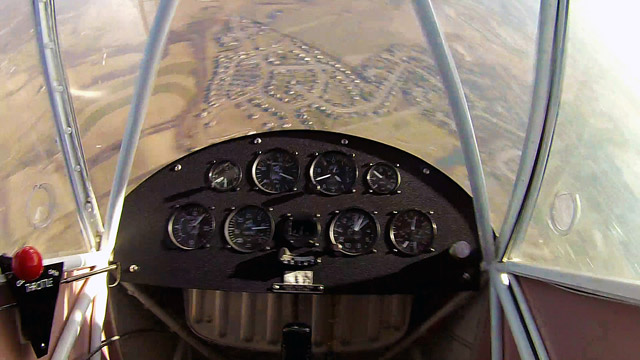Technique: The spin zone
Confronting aviation's intimidator

Spins are the aviation equivalent of a schoolyard bully. They are intimidating and carry a fearsome reputation—but like most bullies, once confronted, spins turn out not to be so tough after all. With proper preparation, training, and equipment, spins can be understood, and even enjoyed, just like the many other maneuvers pilots learn.
Spins can be frightening because they introduce banks well in excess of 90 degrees and steep pitch attitudes that typically reach about 70 degrees nose down. Spins seem to imbue our airplanes with a disorienting and unpredictable will of their own. And spins can cause alarm because “normal” control inputs don’t produce the anticipated results. (For example, adding power and pulling back on the stick during a spin doesn’t bring about a climb, and opposite aileron doesn’t stop—or even slow—the turn rate.)
On top of all this, student pilots are told that a bungled stall recovery or uncoordinated handling of the controls can produce a spin, and an inadvertent spin can result in fiery death. Yet few flight instructors teach spins, and even fewer flight schools have aircraft suitable for performing them safely.
This broad lack of familiarity helps perpetuate spin myths among pilots and the mass media. (My personal favorite is this spin-related non sequitur from Top Gun: “Mav’s in trouble. He’s in a flat spin. He’s heading out to sea!”)
In an effort to demystify spins, AOPA attached video cameras to a clipped-wing Piper J–3 Cub for a close-up look at the control surfaces during a series of spins and spin recoveries. These are upright, unaccelerated spins entered from level flight with the power at idle. The pilot holds pro-spin inputs (full aft stick, and full rudder in the direction of spin, with ailerons neutral) until the spin is fully developed, then recovers using the standard method of idle power, neutral ailerons, full opposite rudder, and brisk forward stick.
Here are a few things to watch for in the video:
- Pay close attention to the inclinometer in the center of the instrument panel during the spin, and notice how the ball swings to full deflection at the spin entry, then moves toward the middle as the spin develops.
- Watch the airspeed indicator and note where it settles during the spin. See how the airspeed indication is higher when spinning to the right than spinning left. (The pitot tube on this particular Cub is located on the left wing, so it senses a substantial amount of ram air pressure when spinning to the right, and almost none when spinning left.)
- Pinpoint the exact moment of spin recovery by the sudden rise in airspeed.
- Also, watch the airplane’s rate of rotation as the spin progresses. The first turn is relatively slow and sedate in what’s called the incipient phase. Then the spin accelerates in turns two and three before finding a steady state in the developed phase.
- See if you can detect subtle differences in the airplane’s pitch and rate of rotation when spinning left compared to spinning right.
- The altimeter unwinds as the airplane descends during the spin, but at what rate? Take note of how much altitude is lost during the maneuver. (Most general aviation trainers lose about 500 feet per turn in a spin, but the diminutive, fast-turning Cub comes down at a different rate.)
The FAA’s predecessor, the CAA, used to require spin training for all private pilots before 1949, and removing spins from the training curriculum and checkride was highly controversial at that time. Many pilots and flight instructors predicted the change would lead to a dramatic increase in spin accidents, but happily, those pessimistic forecasts have proven wrong.
In fact, as flight training emphasized spin avoidance, and aircraft designs became more spin resistant, general aviation safety improved. But the AOPA Air Safety Institute shows stall/spin accidents still accounted for about six percent of all GA accidents—and 13.2 percent of fatalities—in the decade that ended in 2010.
Even though U.S. flight instructors are required to demonstrate “instructional knowledge” of spin theory and recovery techniques, few CFIs have much practical experience learning or teaching them.
A 2005 Embry-Riddle Aeronautical University survey of flight instructors showed 56 percent received less than one hour of ground training prior to getting their spin endorsements, and 59 percent had spin experience in two aircraft models or fewer. Also, the FAA certification process for Normal category airplanes has changed a great deal since 1949, and few new aircraft designs are approved for spins. Normal category airplanes are only required to demonstrate in certification tests that they can recover from a one-turn spin in not more than one additional turn, or three seconds, using normal recovery methods. Such recoveries are initiated during the incipient spin phase, and they provide absolutely no assurance that recovery from fully developed spins is possible.
Aerobatic category airplanes must satisfy a far more demanding spin test of six turns with recovery in 1.5 turns or less using normal recovery methods.
Since most fatal stall/spin accidents are caused by departing controlled flight at low altitude—such as a skidded base-to-final turn in the airport traffic pattern, or an attempted turn toward the airport following an engine failure—even perfect spin recovery technique would be useless because there’s insufficient altitude.
But spin training can be valuable even if it only accomplishes what stall-avoidance training was supposed to do: ensure that pilots recognize the onset of a stall, and ingrain the proper recovery reflex of lowering the angle of attack and eliminating yaw. (If an airplane doesn’t stall, it can’t spin. And even if it does stall, if it doesn’t yaw, it can’t spin.)
Once pilots understand spins and are comfortable entering and recovering from them, they’ve successfully confronted aviation’s schoolyard bully. They gain confidence, lose fear, and enhance their enjoyment of flying—and no one can take their lunch money.
Email [email protected].


